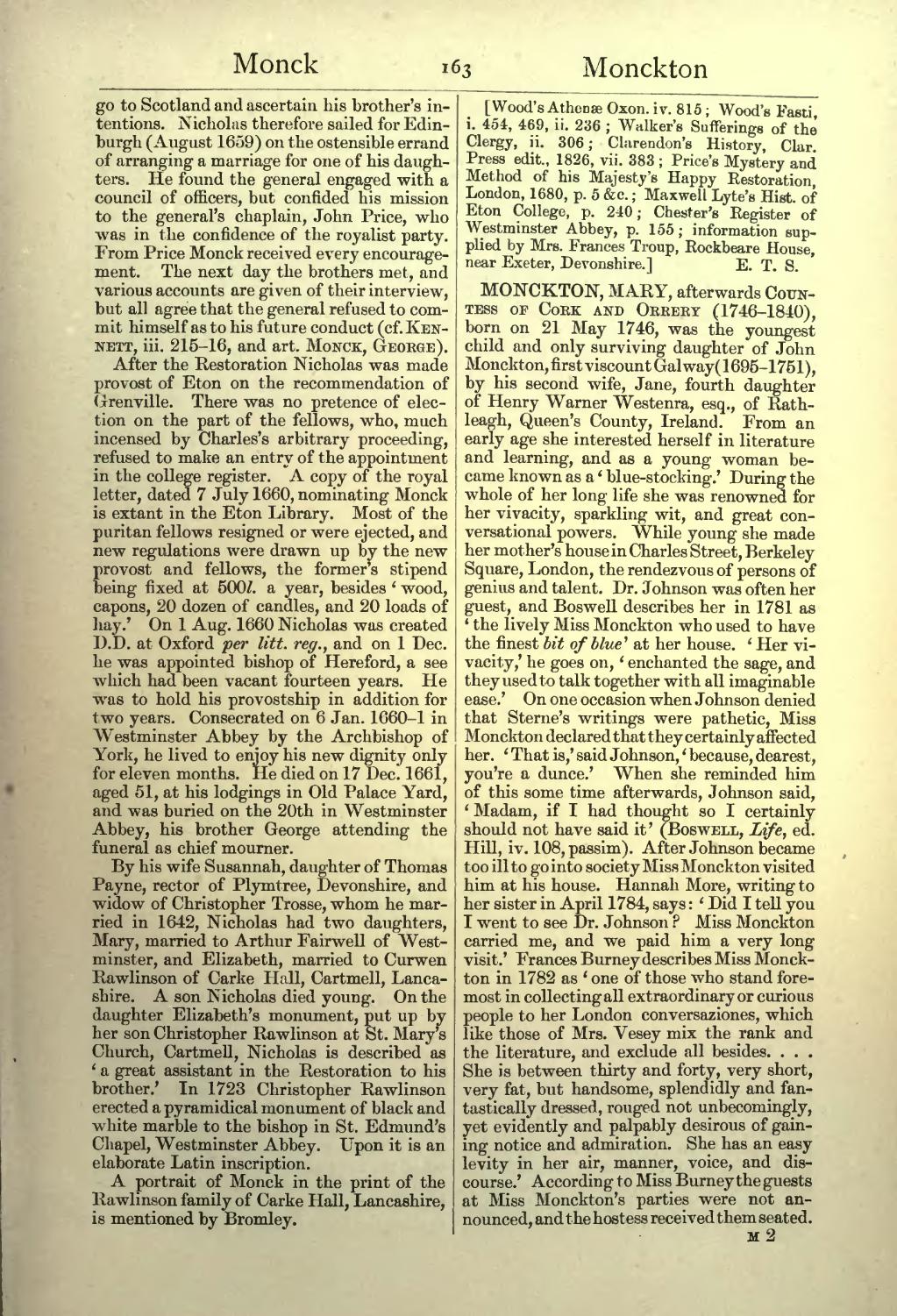go to Scotland and ascertain his brother's intentions. Nicholas therefore sailed for Edinburgh (August 1659) on the ostensible errand of arranging a marriage for one of his daughters. He found the general engaged with a council of officers, but confided his mission to the general's chaplain, John Price, who was in the confidence of the royalist party. From Price Monck received every encouragement. The next day the brothers met, and various accounts are given of their interview, but all agree that the general refused to commit himself as to his future conduct (cf. Kennett, iii. 215-16, and art. Monck, George).
After the Restoration Nicholas was made provost of Eton on the recommendation of Grenville. There was no pretence of election on the part of the fellows, who, much incensed by Charles's arbitrary proceeding, refused to make an entry of the appointment in the college register. A copy of the royal letter, dated 7 July 1660, nominating Monck is extant in the Eton Library. Most of the puritan fellows resigned or were ejected, and 'new regulations were drawn up by the new provost and fellows, the former's stipend being fixed at 500l. a year, besides 'wood, capons, 20 dozen of candles, and 20 loads of hay.' On 1 Aug. 1660 Nicholas was created D.D. at Oxford per lift, reg., and on 1 Dec. he was appointed bishop of Hereford, a see which had been vacant fourteen years. He was to hold his provostship in addition for two years. Consecrated on 6 Jan. 1660-1 in Westminster Abbey by the Archbishop of York, he lived to enjoy his new dignity only for eleven months. He died on 17 Dec. 1661, aged 51, at his lodgings in Old Palace Yard, and was buried on the 20th in Westminster Abbey, his brother George attending the funeral as chief mourner.
By his wife Susannah, daughter of Thomas Payne, rector of Plymtree, Devonshire, and widow of Christopher Trosse, whom he married in 1642, Nicholas had two daughters, Mary, married to Arthur Fairwell of Westminster, and Elizabeth, married to Curwen Rawlinson of Carke Hall, Cartmell, Lancashire. A son Nicholas died young. On the daughter Elizabeth's monument, put up by her son Christopher Rawlinson at St. Mary's Church, Cartmell, Nicholas is described as 'a great assistant in the Restoration to his brother.' In 1723 Christopher Rawlinson erected a pyramidical monument of black and white marble to the bishop in St. Edmund's Chapel, Westminster Abbey. Upon it is an elaborate Latin inscription.
A portrait of Monck in the print of the Rawlinson family of Carke Hall, Lancashire, is mentioned by Bromley.
Wood's Athenæ Oxon. iv. 815; Wood's Fasti, i. 454, 469, ii. 236; Walker's Sufferings of the Clergy, ii. 306; Clarendon's History, Clar. Press edit., 1826, vii. 383; Price's Mystery and Method of his Majesty's Happy Restoration, London, 1680, p. 5 &c.; Maxwell Lyte's Hist. of Eton College, p. 240; Chester's Register of Westminster Abbey, p. 155; information supplied by Mrs. Frances Troup, Rockbeare House, near Exeter, Devonshire.]
MONCKTON, MARY, afterwards Countess of Cork and Orrery (1746–1840), born on 21 May 1746, was the youngest child and only surviving daughter of John Monckton, first viscount Galway (1695-1751), by his second wife, Jane, fourth daughter of Henry Warner Westenra, esq., of Rathleagh, Queen's County, Ireland. From an early age she interested herself in literature and learning, and as a young woman became known as a 'blue-stocking.' During the whole of her long life she was renowned for her vivacity, sparkling wit, and great conversational powers. While young she made her mother's house in Charles Street, Berkeley Square, London, the rendezvous of persons of genius and talent. Dr. Johnson was often her guest, and Boswell describes her in 1781 as 'the lively Miss Monckton who used to have the finest bit of blue at her house. 'Her vivacity,' he goes on, 'enchanted the sage, and they used to talk together with all imaginable ease.' On one occasion when Johnson denied that Sterne's writings were pathetic, Miss Monckton declared that they certainly affected her. 'That is,' said Johnson, 'because, dearest, you're a dunce.' When she reminded him of this some time afterwards, Johnson said, 'Madam, if I had thought so I certainly should not have said it' (Boswell, Life, ed. Hill, iv. 108, passim). After Johnson became too ill to go into society Miss Monckton visited him at his house. Hannah More, writing to her sister in April 1784, says : 'Did I tell you I went to see Dr. Johnson ? Miss Monckton carried me, and we paid him a very long visit.' Frances Burney describes Miss Monckton in 1782 as 'one of those who stand foremost in collecting all extraordinary or curious people to her London conversaziones, which like those of Mrs. Vesey mix the rank and the literature, and exclude all besides. . . . She is between thirty and forty, very short, very fat, but handsome, splendidly and fantastically dressed, rouged not unbecomingly, yet evidently and palpably desirous of gaining notice and admiration. She has an easy levity in her air, manner, voice, and discourse.' According to Miss Burney the guests at Miss Monckton's parties were not announced, and the hostess received them seated.
